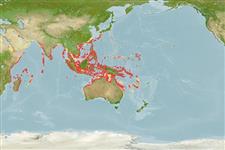Common names from other countries
>
Syngnathiformes (Pipefishes and seahorses) >
Centriscidae (Snipefishes and shrimpfishes) > Centriscinae
Etymology: Aeoliscus: Derived from Aeolius, region from Asia Minor and Aeolus, the Greek god of winds (Ref. 45335).
More on author: Günther.
Environment: milieu / climate zone / depth range / distribution range
Ökologie
seewasser riff-verbunden; tiefenbereich 2 - 42 m (Ref. 90102). Tropical; 32°N - 32°S, 38°E - 170°E
Indo-West Pacific: Tanzania (Ref. 51015) and Seychelles (Ref. 1623); then from southern Japan to New South Wales, Australia eastward to Vanuatu.
Size / Gewicht / Alter
Maturity: Lm ? range ? - ? cm
Max length : 15.0 cm TL Männchen/unbestimmt; (Ref. 1602)
Kurzbeschreibung
Morphologie | Morphometrie
Rückenflossenstacheln (insgesamt): 3; Rückenflossenweichstrahlen (insgesamt): 9-10; Afterflossenstacheln 0; Afterflossenweichstrahlen: 12. Recognized by hinged part of dorsal fin spine. Variable in color with habitat. Greenish-yellow with diffused stripe when in seagrass environment. Pale with black stripe when found on open substrate with white sand or rubble (Ref. 48635).
Form schools among the spines of Diadema or staghorn corals, and feed on minute crustaceans in the zooplankton. Remarkable for their strange body shape and swimming habit: the body is encased in an armor of thin, transparent plates; they swim in synchronized groups, each fish in a vertical position with the snout pointing downwards.
Life cycle and mating behavior
Geschlechtsreife | Fortpflanzung | Ablaichen | Eier | Fecundity | Larven
Myers, R.F., 1991. Micronesian reef fishes. Second Ed. Coral Graphics, Barrigada, Guam. 298 p. (Ref. 1602)
IUCN Rote Liste Status (Ref. 130435)
Warning: mysqli::__construct(): (HY000/1040): Too many connections in /var/www/html/includes/func_getlabel.php on line 46
Can't connect to MySQL database (fbapp). Errorcode: Too many connections
